Fault Diagnosis for PEMFC Water Management Subsystem Based on Learning Vector Quantization Neural Network and Kernel Principal Component Analysis
Abstract
:1. Introduction
2. Proton Exchange Membrane Fuel Cell (PEMFC) Power System and Water Management Failures
2.1. PEMFC Test System
2.2. Types of Water Management Failure
2.2.1. Water Flooding Failure
2.2.2. Dry Membrane Failure
3. Diagnostic Methods
3.1. Kernel Principal Component Analysis (KPCA)
3.2. Learning Vector Quantization Neural Network (LVQNN)
3.3. KPCA-LVQNN
- Collect the original data. By setting the operating parameters at the rated value, reducing the temperature of PEMFC and reducing the humidity of reaction gas, the PEMFC stack can be in a normal state, water flooding fault state and membrane dry fault state, respectively. The original experimental data of PEMFC system can then be collected in real time with the help of temperature, pressure, flow and voltage sensors.
- Pre-process data. In order to reduce the dimensional differences between different parameters in the original experimental data, the original experimental data are standardized.
- Reduce data dimension. In the original experimental data standardization, the dimension of the data is still very high and has strong coupling, and there are characteristic parameters not related to the diagnosis results. KPCA is used to determine the variance contribution rate and the number of principal components, reduce the dimension of the input feature quantity, and change it into a group of linearly unrelated variables, and finally complete the extraction of fault feature vector.
- Divide the dimensionality-reduced feature data of health status into training and test samples with an ratio of 60% and 40%, respectively.
- Train the neural network. The training set is introduced into LVQNN model to get the trained LVQNN diagnosis model.
- Test the diagnostic results. The test set is input into the trained KPCA-LVQNN and the fault detection results are output.
- Analyze diagnostic results. The performance and feasibility of KPCA-LVQNN are evaluated by calculating the correct rate, false alarm rate and rejection rate, drawing the diagnosis result graph and establishing the confusion matrix. The feasibility of the method is evaluated by comparing with back propagation neural network (BPNN).
4. Results and Discussion
4.1. Experimental Data Acquisition
4.2. Fault Feature Vector Extraction
4.3. Fault Diagnosis Results
4.4. Comparative Analysis
5. Conclusions
- The KPCA algorithm can reduce the dimension of high-dimensional data, which can extract the essential characteristics of data, and reduce the calculation time. The cumulative contribution rate reaches 95% in the experiment, indicating that the first five principal components can characterize 14-dimensional sample data.
- LVQNN is a self-organizing competitive network with supervised learning, which has a good performance in recognition effect. The analysis results of samples show that the proposed method can accurately diagnose the PEMFC system with three health states: normal state, membrane dry fault and water flooding fault. The recognition accuracy of training set samples and test set samples are 97.6% and 96.9%, respectively, and the operation time is 2.5333 s. The FAR of training set is 1.28% and the FRR is 2.80%. The FAR of the test set is 2.05% and the FRR is 3.42%.
- The proposed method is particularly suitable for processing health status data with high dimensions and abundant samples. Compared with the BPNN method, it is found that the proposed method has higher fault diagnosis accuracy and less computation time, with the testing accuracy improved by 21.22% and the time is shortened by 6.2743 s.
- The proposed KPCA-LVQNN method can not only solve the problem of PEMFC water management subsystem fault diagnosis, but also can be applied in a broader range of engineering fields. Given insufficient experimental conditions, only three health states were detected in this work. Future studies will include more types of health state for detection by collecting more original feature data of failure types.
Author Contributions
Funding
Conflicts of Interest
References
- Chen, W.; Liu, J.; Li, Q. Review and Prospect of Fault Diagnosis Methods for Proton Exchange Membrane Fuel Cell. Proc. CSEE 2017, 37, 4712–4721. (In Chinese) [Google Scholar]
- Li, Q.; Liu, J.; Chen, W. Review and Prospect of Remaining Useful Life Prediction Methods for Proton Exchange Membrane Fuel Cell. Proc. CSEE 2019, 39, 2365–2375. (In Chinese) [Google Scholar]
- Ghoneim, S.S.; Mahmoud, K.; Lehtonen, M.; Darwish, M.M. Enhancing Diagnostic Accuracy of Transformer Faults Using Teaching-Learning-Based Optimization. IEEE Access 2021, 9, 30817–30832. [Google Scholar] [CrossRef]
- Abbas, A.S.; El-Sehiemy, R.A.; El-Ela, A.; Ali, E.S.; Mahmoud, K.; Lehtonen, M.; Darwish, M.M. Optimal Harmonic Mitigation in Distribution Systems with Inverter Based Distributed Generation. Appl. Sci. 2021, 11, 774. [Google Scholar] [CrossRef]
- Abaza, A.; El-Sehiemy, R.A.; Mahmoud, K.; Lehtonen, M.; Darwish, M.M. Optimal Estimation of Proton Exchange Membrane Fuel Cells Parameter Based on Coyote Optimization Algorithm. Appl. Sci. 2021, 11, 2052. [Google Scholar] [CrossRef]
- Yu, J.; Li, Q.; Chen, W. A Fault Classification Method of High-power Proton Exchange Membrane Fuel Cell Systems Based on the Random Forest. Proc. CSEE 2020, 40, 5591–5599. (In Chinese) [Google Scholar]
- Tran, M.Q.; Elsisi, M.; Mahmoud, K.; Liu, M.K.; Lehtonen, M.; Darwish, M.M. Experimental setup for online fault diagnosis of induction machines via promising IoT and machine learning: Towards industry 4.0 empowerment. IEEE Access 2021, 9, 115429–115441. [Google Scholar] [CrossRef]
- Elsisi, M.; Tran, M.Q.; Mahmoud, K.; Mansour, D.E.A.; Lehtonen, M.; Darwish, M.M. Towards Secured Online Monitoring for Digitalized GIS Against Cyber-Attacks Based on IoT and Machine Learning. IEEE Access 2021. to be published. [Google Scholar] [CrossRef]
- Lei, M.; Jackson, L. Effect of sensor set size on polymer electrolyte membrane fuel cell fault diagnosis. Sensors 2018, 18, 2777. [Google Scholar]
- Lei, M.; Jackson, L.; Davies, B. Investigation of PEMFC fault diagnosis with consideration of sensor reliability. Int. J. Hydrogen Energy 2018, 43, 16941–16948. [Google Scholar]
- Lei, M.; Jackson, L.; Davies, B. Effectiveness of a novel sensor selection algorithm in PEM fuel cell on-line diagnosis. IEEE Trans. Ind. Electron. 2018, 65, 7301–7310. [Google Scholar]
- Li, Z.; Giurgea, S.; Outbib, R. Online diagnosis of PEMFC by combining support vector machine and fluidic model. Fuel Cells 2014, 14, 448–456. [Google Scholar] [CrossRef]
- Li, Z.; Cadet, C.; Outbib, R. Diagnosis for PEMFC Based on Magnetic Measurements and Data-Driven Approach. IEEE Trans. Energy Convers. 2019, 34, 964–972. [Google Scholar] [CrossRef]
- Wang, H.; Peng, M.; Yu, Y. Fault identification and diagnosis based on KPCA and similarity clustering for nuclear power plants. Ann. Nucl. Energy 2021, 150, 107786. [Google Scholar] [CrossRef]
- Montazeri, A.; Kargar, S.M. Fault detection and diagnosis in air handling using data-driven methods. J. Build. Eng. 2020, 31, 101388. [Google Scholar] [CrossRef]
- Neffati, S.; Ben Abdellafou, K.; Taouali, O. Enhanced SVM–KPCA method for brain MR image classification. Comput. J. 2020, 63, 383–394. [Google Scholar] [CrossRef]
- Qu, N.; Zuo, J.; Chen, J. Series arc fault detection of indoor power distribution system based on LVQ-NN and PSO-SVM. IEEE Access 2019, 7, 184020–184028. [Google Scholar] [CrossRef]
- Liu, J.; Zuo, B.; Zeng, X. Nonwoven uniformity identification using wavelet texture analysis and LVQ neural network. Expert Syst. Appl. 2010, 37, 2241–2246. [Google Scholar] [CrossRef]
- Mao, L.; Davies, B.; Jackson, L. Application of the sensor selection approach in polymer electrolyte membrane fuel cell prognostics and health management. Energies 2017, 10, 1511. [Google Scholar] [CrossRef] [Green Version]
- Ni, J.; Zhang, C.; Yang, S.X. An adaptive approach based on KPCA and SVM for real-time fault diagnosis of HVCBs. IEEE Trans. Power Deliv. 2011, 26, 1960–1971. [Google Scholar] [CrossRef]
- Simmini, F.; Rampazzo, M.; Peterle, F.; Susto, G.A.; Beghi, A. A Self-Tuning KPCA-Based Approach to Fault Detection in Chiller Systems. IEEE Trans. Control Syst. Technol. 2021. [Google Scholar] [CrossRef]
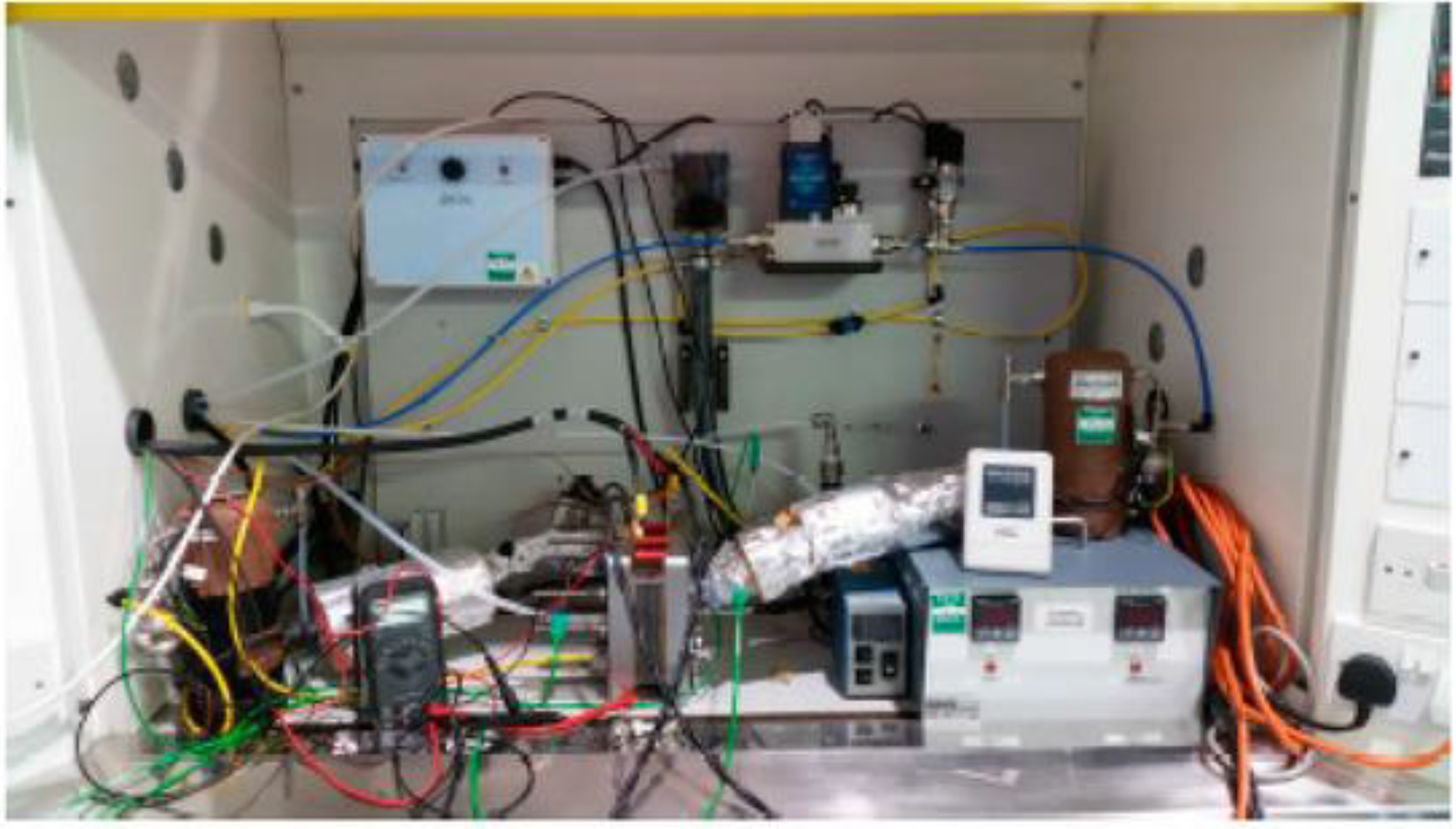

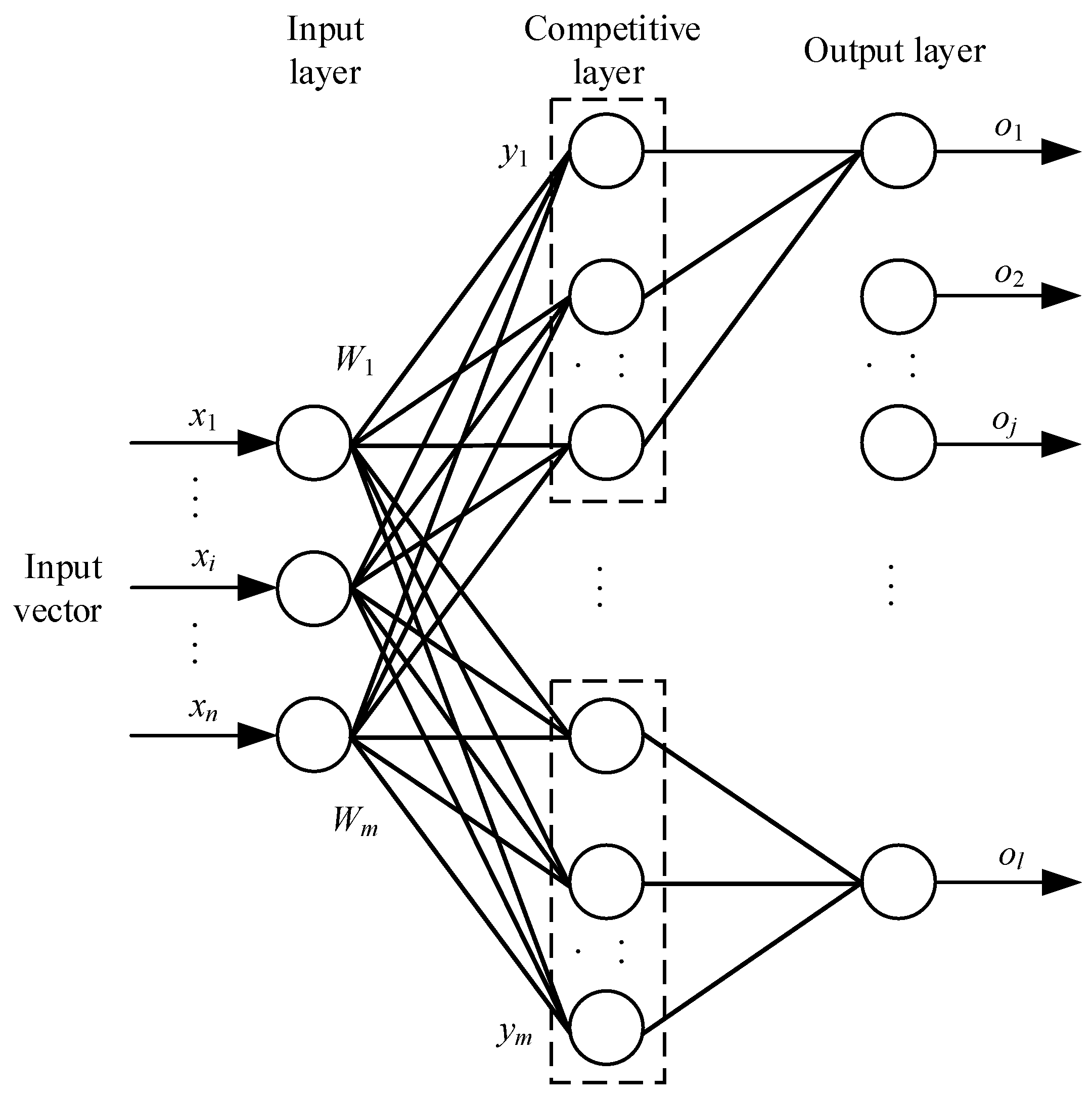
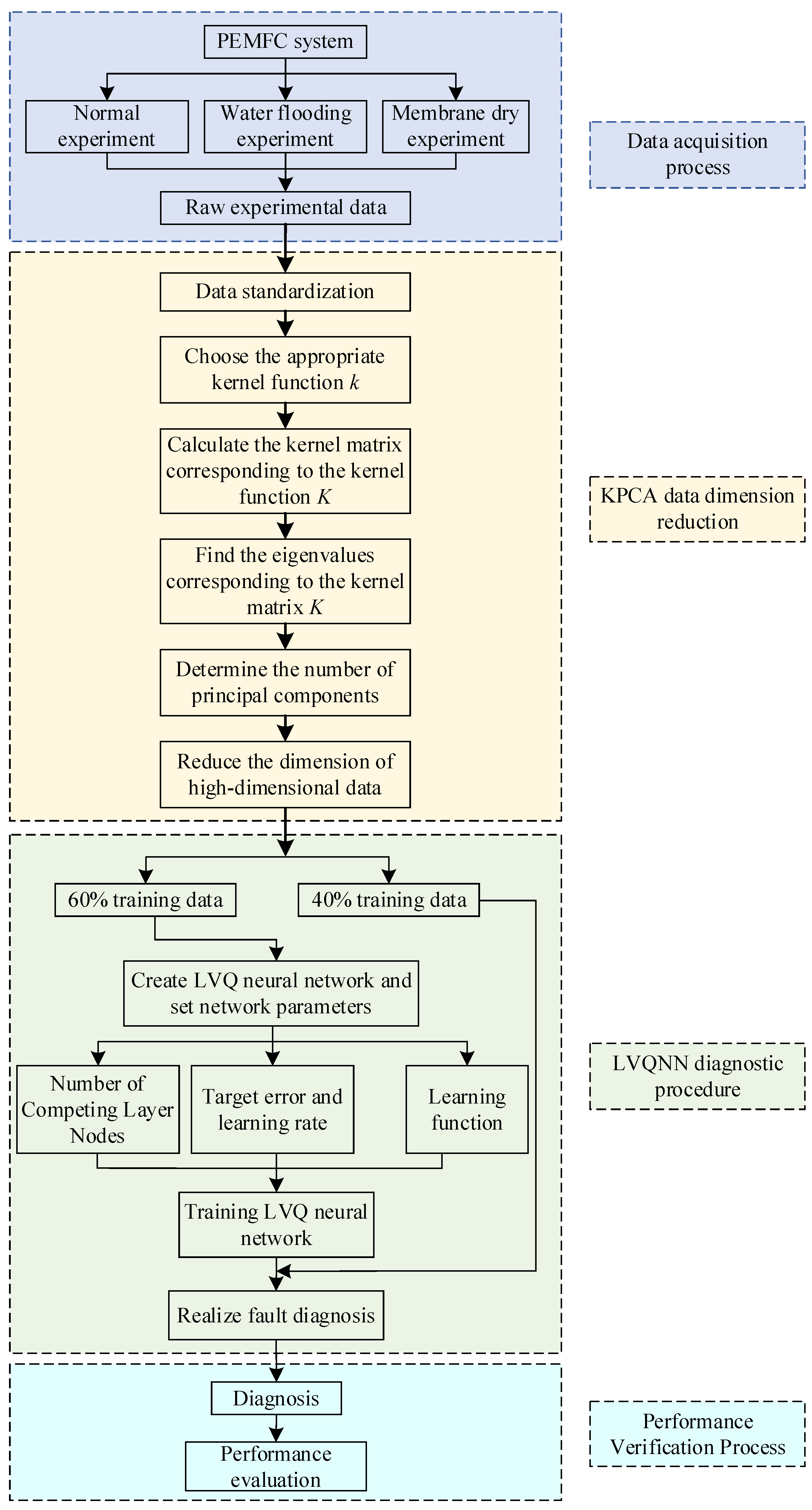

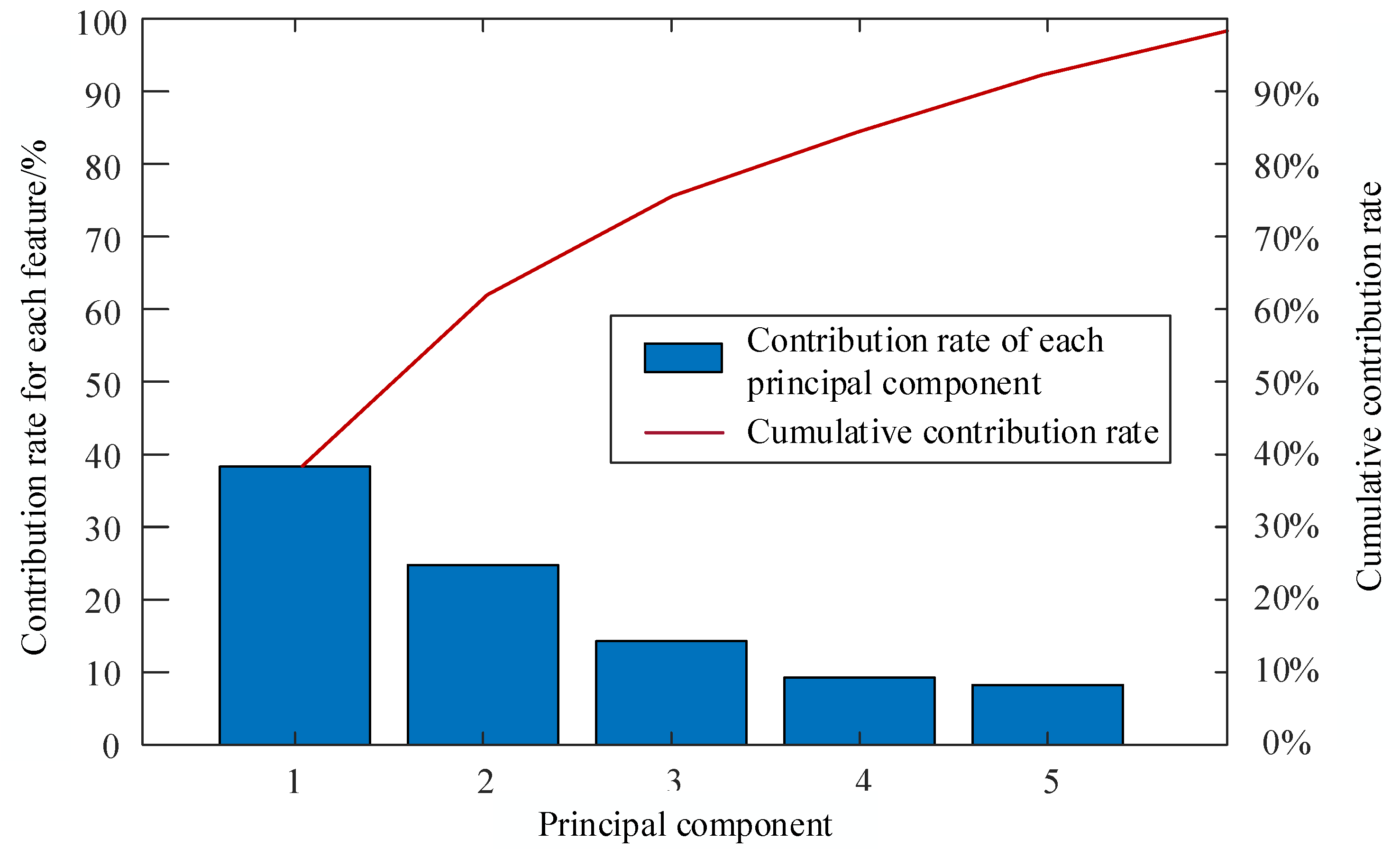
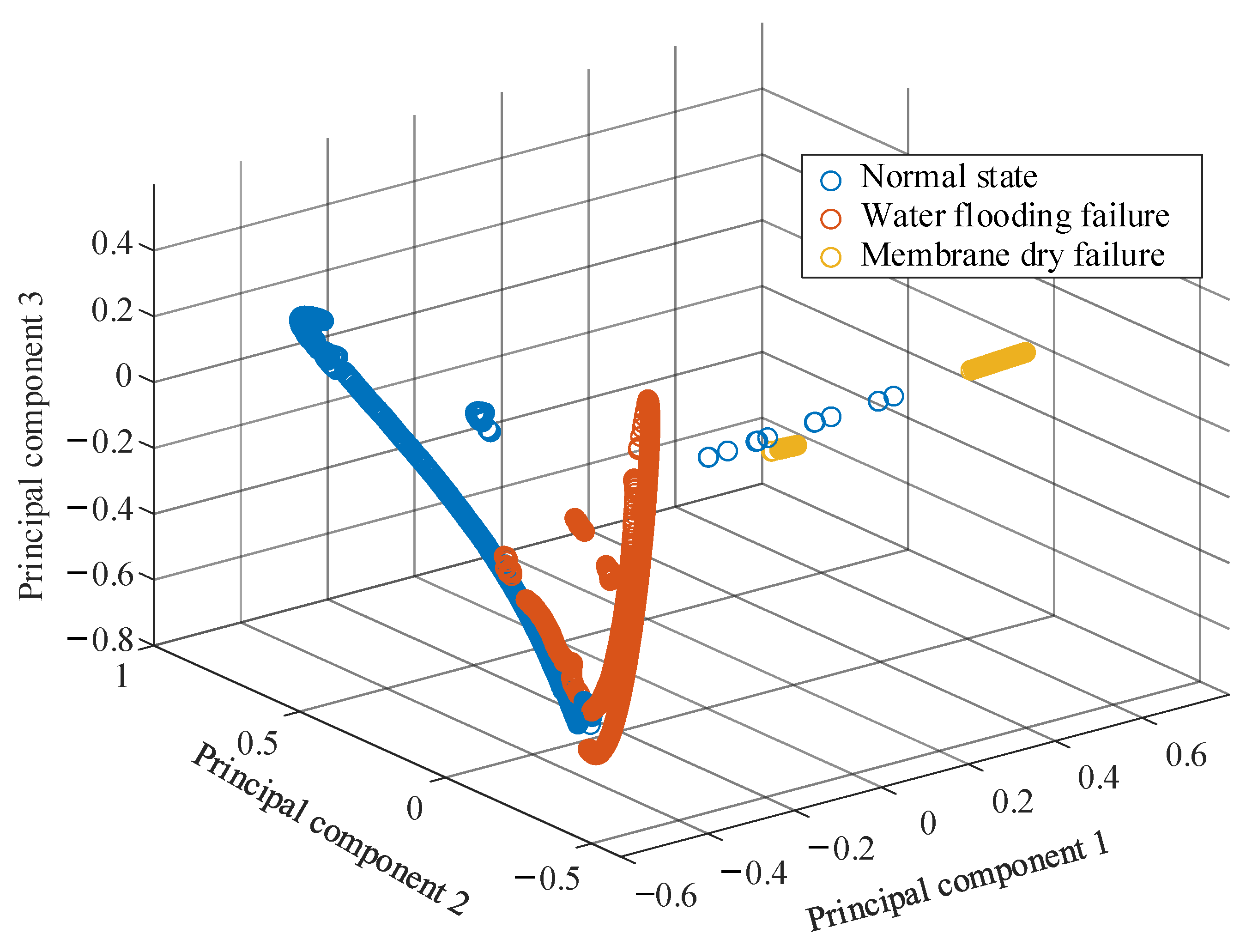
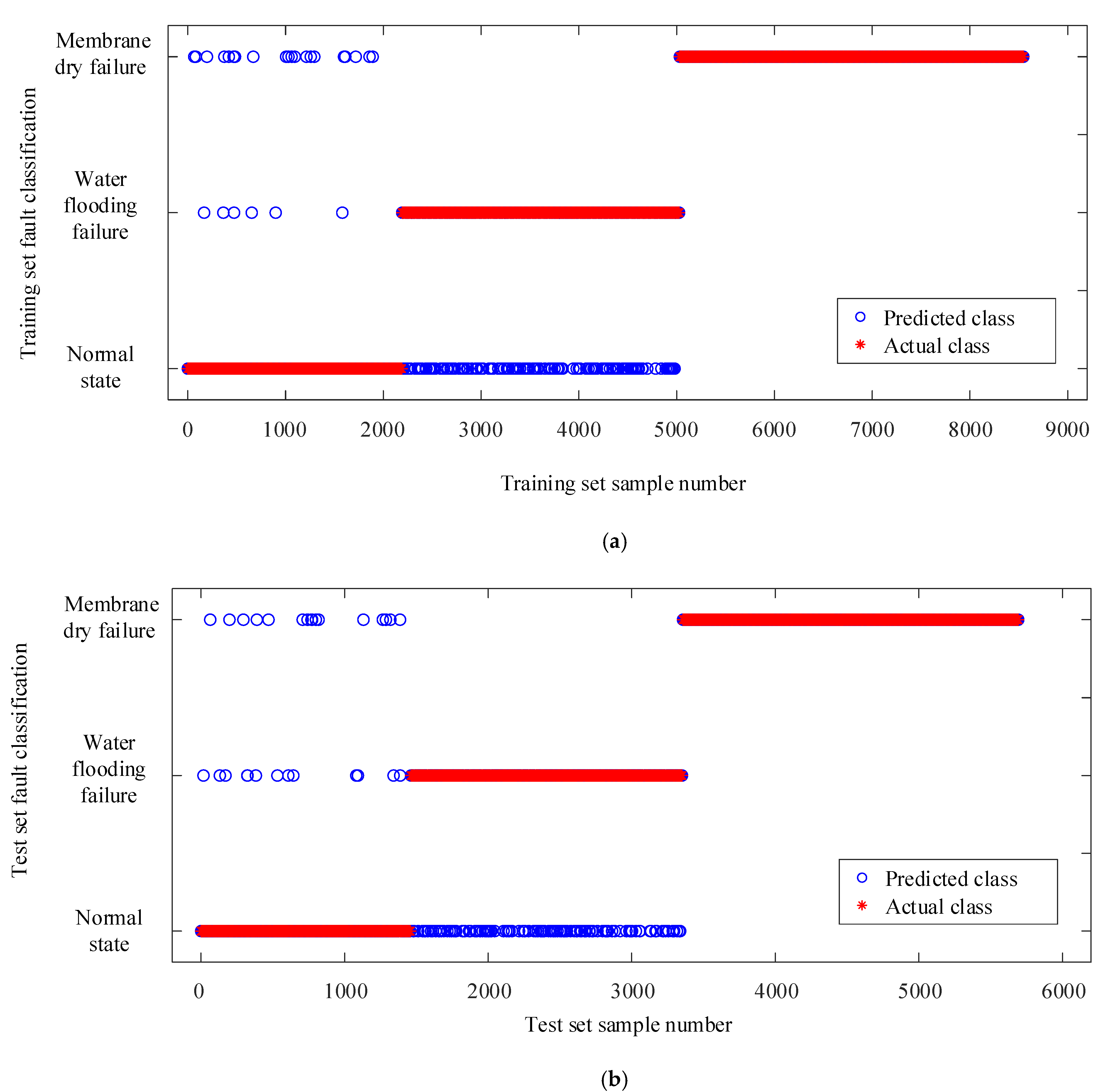
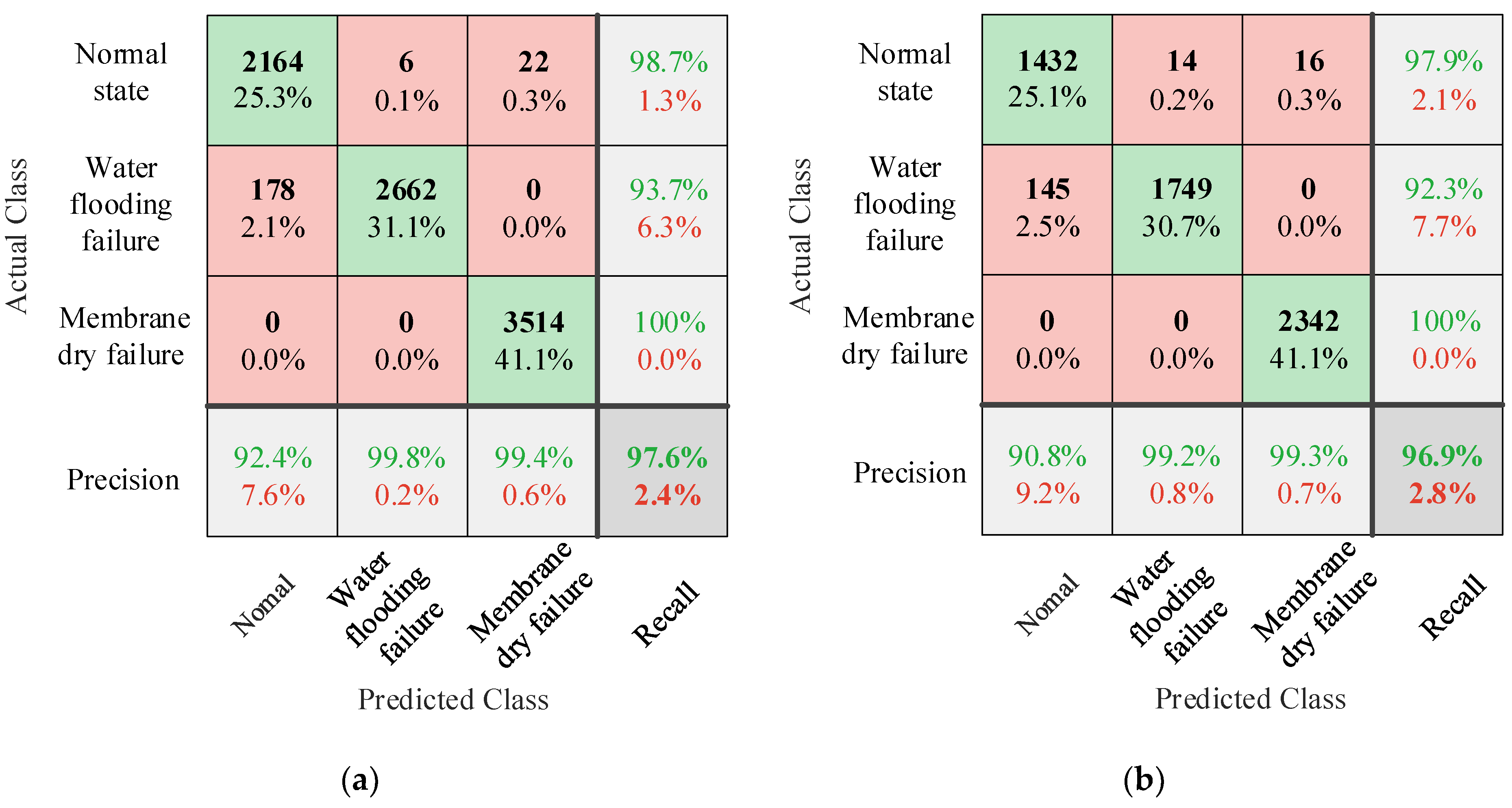

| Parameter | Value |
|---|---|
| Active area (cm2) | 100 |
| rated power (W) | 80 |
| film thickness (μm) | 25 |
| Platinum loading(mg/cm2) | 0.2 |
| Thickness of gas diffusion layer (μm) | 415 |
| Number | Variable | Unit |
|---|---|---|
| 1 | Single stack voltage | V |
| 2 | Single stack current | A |
| 3 | Single stack power | W |
| 4 | Stack inlet air flow rate | SPLM |
| 5 | Stack inlet hydrogen flow rate | SPLM |
| 6 | Stack inlet air pressure | Bar |
| 7 | Stack inlet hydrogen pressure | Bar |
| 8 | Stack outlet air pressure | Bar |
| 9 | Stack outlet hydrogen pressure | Bar |
| 10 | Stack inlet air temperature | °C |
| 11 | Stack inlet hydrogen temperature | °C |
| 12 | Stack outlet temperature | °C |
| 13 | Heater temperature | °C |
| 14 | Heater power | W |
| Type | Number | Principal Component | ||||
|---|---|---|---|---|---|---|
| 1 | 2 | 3 | 4 | 5 | ||
| Normal state | 1 | −0.2393 | 0.7391 | −0.2429 | 0.1793 | 0.0036 |
| 2 | −0.2393 | 0.7391 | −0.2429 | 0.1793 | 0.0036 | |
| 3 | −0.2391 | 0.7372 | −0.2401 | 0.1744 | 0.0116 | |
| Water flooding failure | 4 | −0.5418 | −0.4562 | −0.4788 | −0.0598 | 0.1566 |
| 5 | −0.5418 | −0.4562 | −0.4787 | −0.0598 | 0.1566 | |
| 6 | −0.5414 | −0.4558 | −0.4785 | −0.0597 | 0.1565 | |
| Membrane dry failure | 7 | 0.6790 | −0.1276 | 0.0063 | 0.0980 | 0.0342 |
| 8 | 0.6790 | −0.1276 | 0.0063 | 0.0980 | 0.0342 | |
| 9 | 0.6796 | −0.1278 | 0.0063 | 0.0984 | 0.0344 | |
| Health Condition | Normal State | Water Flooding Fault | Membrane Dry Fault | Total Correct Rate | |
|---|---|---|---|---|---|
| Detection Method | |||||
| KPCA and LVQNN | 98.95% | 92.34% | 100% | 96.93% | |
| Unpretreated LVQNN | 96.51% | 82.31% | 100% | 93.23% | |
| KPCA and BPNN | 96.51% | 84.37% | 71.14% | 82.04% | |
| Unpretreated BPNN | 66.07% | 74.87% | 82.41% | 75.71% | |
| Detection Method | LVQNN | BPNN | ||
|---|---|---|---|---|
| Using KPCA Dimension Reduction | Without Dimension Reduction | Using KPCA Dimension Reduction | Without Dimension Reduction | |
| Computation time (s) | 2.5333 | 3.9743 | 6.9250 | 8.8076 |
Publisher’s Note: MDPI stays neutral with regard to jurisdictional claims in published maps and institutional affiliations. |
© 2021 by the authors. Licensee MDPI, Basel, Switzerland. This article is an open access article distributed under the terms and conditions of the Creative Commons Attribution (CC BY) license (https://creativecommons.org/licenses/by/4.0/).
Share and Cite
Jiang, S.; Li, Q.; Gan, R.; Chen, W. Fault Diagnosis for PEMFC Water Management Subsystem Based on Learning Vector Quantization Neural Network and Kernel Principal Component Analysis. World Electr. Veh. J. 2021, 12, 255. https://doi.org/10.3390/wevj12040255
Jiang S, Li Q, Gan R, Chen W. Fault Diagnosis for PEMFC Water Management Subsystem Based on Learning Vector Quantization Neural Network and Kernel Principal Component Analysis. World Electric Vehicle Journal. 2021; 12(4):255. https://doi.org/10.3390/wevj12040255
Chicago/Turabian StyleJiang, Shuna, Qi Li, Rui Gan, and Weirong Chen. 2021. "Fault Diagnosis for PEMFC Water Management Subsystem Based on Learning Vector Quantization Neural Network and Kernel Principal Component Analysis" World Electric Vehicle Journal 12, no. 4: 255. https://doi.org/10.3390/wevj12040255
APA StyleJiang, S., Li, Q., Gan, R., & Chen, W. (2021). Fault Diagnosis for PEMFC Water Management Subsystem Based on Learning Vector Quantization Neural Network and Kernel Principal Component Analysis. World Electric Vehicle Journal, 12(4), 255. https://doi.org/10.3390/wevj12040255






